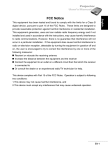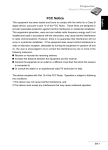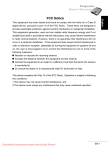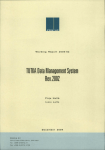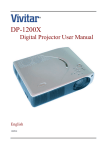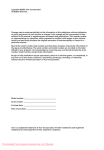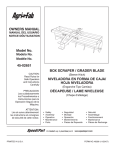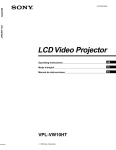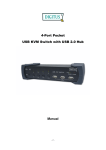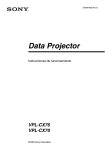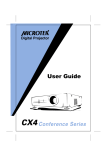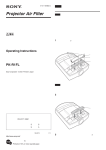Download Vivitar DP1500 X User's Manual
Transcript
Digital Projector User Manual Projector User’s Manual original purchaser. In case of defects in materials or workmanship, Vivitar will repair or replace the projector free of charge. This warranty applies to the projector only . ENGLISH . Warranty Policy This projector is under warranty for one full year from the date of purchase by the and does not include batteries or other accessories. This warranty will not be honored if the projector has been mishandled or tampered with, or altered by anyone other than the manufacturer. Other than for the warranty herein, Vivitar is not responsible for loss, damage, or inconvenience of any kind. A defective projector being returned under warranty must be accompanied by a description of the problem and proof of purchase with the date of purchase clearly indicated. All related transportation costs and insurances are at the owner’s expense. Any alteration of this warranty cannot be made without the written approval of Vivitar. FCC Notice This equipment has been tested and found to comply with the limits for a Class B digital device, pursuant to part 15 of the FCC Rules. These limits are designed to provide reasonable protection against harmful interference in commercial installation. This equipment generates, uses and can radiate radio frequency energy and if not installed and used in accordance with the instructions, may cause harmful interference to radio communications. However, there is no guarantee that interference will not occur in a particular installation. If this equipment does cause harmful interference to radio or television reception, detectable by turning the equipment in question off and on, the user is encouraged to try to correct the interference by one or more of the following measures: Reorient or relocate the receiving antenna Increase the distance between the equipment and the receiver Connect the equipment to an outlet on a different circuit than that to which the receiver is connected Consult the dealer or an experienced radio/TV technician for help This device complies with Part 15 of the FCC Rules. Operation is subject to following two conditions: 1. This device may not cause harmful interference, and 2. This device must accept any interference that may cause undesired operation. ○ ○ ○ ○ ○ ○ ○ ○ ○ EN-1 Projector User’s Manual Important Information About Your DP-1500X Please read the following important information about your DP-1500X projector. Important Safety Information Warning: Never look into the projector lens when the lamp is switched on as the bright light can damage your eyes. Never let children look into the lens when it is on. Never open any covers on the projector except the lamp and filter covers. Dangerous electrical voltages inside the projector can cause severe injury. Except as specifically directed in this Instruction Manual, do not attempt to service this product yourself. Refer all service to qualified service personnel. Keep the plastic packing materials (from the projector, accessories and optional parts) out of the reach of children as these bags may result in death by suffocation. Be particularly careful around small children. Caution: When you replace the projector lamp, never touch the new bulb with your bare hands. The invisible residue left by the oil on your hands may be shorten the bulb life. Use a cloth or gloves to handle the new bulb. ○ ○ ○ ○ ○ ○ ○ ○ ○ EN-2 Projector User’s Manual . ENGLISH . Safety Instructions Always follow these safety instructions when setting up and using the projector: 1. Do not place the projector on an unstable stand or table. 2. Do not use the projector near water or sources of heat. 3. Use accessories only as recommended. 4. Use the type of power source indicated on the projector. If you are not sure of the type of power available, consult your dealer. 5. Insert the projector’s three-pin plug into a properly grounded socket. 6. Do not handle the plug or projector with wet hands. 7. Always take the following precautions when handling the plug. Failure to do so may result in shock, damage, or fire. Ensure the plug is free of dust before inserting it into a socket. Ensure that the plug is inserted into the socket securely. 8. Do not overload wall sockets, extension cords, or power strips as this may cause fire or electric shock. 9. Do not place the projector where the cord can be stepped on as this may result in fraying or damage to the lead or the plug. Be alert to tripping hazard. 10. Unplug the projector from the wall socket before cleaning. Use a damp cloth for cleaning the exterior of the projector. Do not use liquid or aerosol cleaners. Ocular Hazards 11. Never look directly into the projector lamp when it is on. 12. Do not position the projector to point directly into an audience. 13. Do not point the laser pointer at anyone, especially near their eyes. Copyright 2003 - Vivitar Corporation www.vivitar.com Rev 030819 ○ ○ ○ ○ ○ ○ ○ ○ ○ EN-3 Projector User’s Manual TABLE OF CONTENTS 6 Projector 7 8 Control Panel Remote Control 8 9 Getting the Most Out of Your Projector Remote Control Auto Off Mode 9 9 Sleep Mode Control Panel Setup 10 Unpacking the Projector 11 12 Setting Up the Projector Connecting to a Computer 12 13 Connecting to a Video Source Using the Projector 13 13 Turning the A/V Equipment On Turning the Projector On and Off 14 14 Focusing and Positioning the Screen Image Operation Indicator 15 EN-4 Button Function 9 9 10 ○ ○ ○ ○ ○ ○ ○ ○ ○ Projector Features and Controls 6 Projector Control Menus 15 Accessing the Main Menu 15 16 Changing a Menu Setting Menu Options 16 18 Input Menu Image Menu 20 21 Computer Menu Audio Menu Projector User’s Manual Misc Menu 24 26 Option Menu Reset Menu 27 . ENGLISH . 22 Maintenance 27 Cleaning the Lens 27 28 Cleaning the Projector Housing Cleaning the Air Filter 28 Replacing the Lamp 29 Technical Specifications 30 Appendix A 30 Preset Signals 31 HDTV Preset Signals ○ ○ ○ ○ ○ ○ ○ ○ ○ EN-5 Projector User’s Manual Projector Features and Controls 7 Projector 2 1. Zoom ring 2. Focus ring 3. Lens 4. Ventilation slots 1 6 (exhaust) 5. Height Adjustment 6. Front IR remote control sensor 7. Speakers 8. Control Panel including 3 8 4 Lamp Power button 9. AC power socket 5 10. Main Power Switch 11. Rear IR remote control sensor 12. Security lock receptacle 13. Control port (PS2 & USB) 14. Audio IN connector 15. DVI connector 19 18 16. Computer IN connector 17. S-video input 20 Component Video Inputs 18. Y jack 19. Cb jack 20. Cr jack 10 9 21. Audio input jacks (L & R) 22. Composite Video input jack 23. Projector Lens Cap (Not Shown) 21 16 11 12 ○ ○ ○ ○ ○ ○ ○ ○ ○ EN-6 14 13 15 17 22 Projector User’s Manual LED POWER Power LED indicator - indicates power to projector LAMP Lamp LED indicator- indicates lamp power . ENGLISH . Control Panel Control Panel Buttons POWER Turns the projector and lamp On and OFF MENU SELECT Displays (or hides) the on-screen control menus Selects the desired menu choice ENTER AUTO Confirms a menu selection Automatically adjusts frequency and phase INPUT KEYSTONE To manually select an input source Adjusts trapezoidal distortion (+ & - ) of the projection which that may occur depending on the horizontal projection angle ○ ○ ○ ○ ○ ○ ○ ○ ○ EN-7 Projector User’s Manual Remote Control Button Function POWER MENU Turns the projector and lamp On and OFF Displays (or hides) the on-screen control menus LASER WINDOW Fires laser pointer (press and hold) Adjusts Window size while in PIP mode AUTO Automatically adjusts frequency and phase (To adjust manually - press enter, Menu/Computer/Tracking, COMPUTER Sync, PosiH, PosiV to fine tune.) Selects computer input signal (computer, DVI, or HDTV) VIDEO PIP Selects video input signal (YCbCr, S-Video, Video) Picture-in-Picture: displays a second image window POINTER Displays pointer icon on the screen Confirms the current setting ESC KEYSTONE Deselects the current setting and exits a menu Adjusts trapezoidal distortion of the projection that may occur VOLUME depending on the horizontal projection angle Adjusts the volume of the projectors speakers FREEZE Freezes the current graphics and video image on the screen BLANK D ZOOM Cuts off the screen temporarily Digitally zooms the current image window MUTE LANGUAGE Temporarily cuts-off the projector speakers Selects the desired OSD (On-Screen THUMB PAD Display) language The thumb pad is a thumb-activated navigational controller. It acts like a small joystick or game controller. Pressing the pad forward or backward allows you to navigate up and down the projector menus. If your projector is equipped with an optional mouse link cable, the controller pad will function as a remote mouse for your PC. ○ ○ ○ ○ ○ ○ ○ ○ ○ EN-8 Projector User’s Manual The projector has a full set of features that allow you to control the settings for video, audio, power management, display parameters, and much more. To derive the . ENGLISH . Getting the Most Out of Your Projector greatest utility from your projector, read the following sections for a summary of these important features. Remote Control The buttons on the remote control allow direct and immediate control of the most commonly used features including source selection, display modes, PIP, keystone adjustment, volume control, video freeze-frame, zoom, video blanking, audio muting, and power control. The remote control buttons can also be used for advanced functions and to access the projector’s menu system. The remote controller can be used as a remote mouse for your PC, and also includes a laser pointer. Auto Off Mode The auto off mode conserves power as well as lamp-life by automatically turning off the lamp if the projector does not detect an input signal for specified period of time - 30 minutes. In the auto off mode, the lamp is turned off, conserving electricity, cooling the projector, and extending the life of the lamp. Use the Power button on either the remote controller or the projector control panel to turn the projector on again if it has powered off. Sleep Mode The sleep mode conserves electricity by automatically turning off the lamp if the projector’s lamp is on continuously for a specified period ( 1 to 3 hours). In sleep mode, the lamp is turned off, conserving electricity, cooling the projector and extending the life of the lamp. Use the Power button to turn the projector on and off. Control Panel The control panel buttons on the top of the projector offer access to advanced functions, such as adjusting the brightness and contrast for computer images. ○ ○ ○ ○ ○ ○ ○ ○ ○ EN-9 Projector User’s Manual Setup This section tells you how to unpack, set up, and connect your projector to other equipment. The projector must be connected to a computer or a video source such as a video tape deck, camcorder, digital camera or notebook computer in order to make a projection. You may connect multiple sources to the projector such as a computer and a video source. You may also connect a computer mouse to use as a controller. Audio may be provided for one, or both, image sources. The audio source can be a computer, a channel of your video source, or another device such as a stereo. Unpacking the Projector When you unpack the projector, make sure you have all these components: Projector Projector carrying case Remote Controller (IR) 2 AAA batteries for the Controller Power cord Computer cable S-Video cable A/V composite cable (RCA type for composite video and audio) Lens cap Instruction manual (The following cables are optional accessories) Audio cable HDTV to D-Sub (When using HDTV as input signal) Mouse cable (for PS/2) Mouse cable (for USB) DVI cable Component Video cable Many of the above optional items may not be required for your particular installation. Retain packaging materials in case you need to move or ship the projector in the future. It should always be transported in its original protective packaging. ○ ○ ○ ○ ○ ○ ○ ○ ○ EN-10 Projector User’s Manual 1. Place the projector on a sturdy, level surface preferably within five feet of the computer or video source. . ENGLISH . Setting Up the Projector Caution: Do not hold the projector by the lens. This can damage the lens. 2. Place the projector the correct distance from the screen. Use the following table as a guideline. Alternatively, as a rough estimate for planning purposes, use this guideline: For every unit (foot, meter) of screen width, the projector must be placed (set back) two units from the screen. The optical zoom capability of the projector allows an adjustment of 30 percent. Distance between the screen and the projector Projection Size (Diagonal) 40” 50” 70” 100” 150” 200” 300” Projection Distance [ft.] Lens at WIDE position 5 7 10 14 20 27 41 Projection Distance [ft.] Lens at TELE position 7 9 12 18 27 36 54 3. When replacing batteries for the remote controller, take the following precautions: Do not recharge used batteries, or expose batteries to fire or water. Replace batteries as soon as they run down. If the batteries leak, wipe away the fluid with a soft cloth. If battery fluid gets on your hands wash them immediately. Remove the batteries if you will not be using the remote controller for a long period of time. ○ ○ ○ ○ ○ ○ ○ ○ ○ EN-11 Projector User’s Manual Connecting to a Computer The projector will always project at XGA (1024 x 768) resolution. (XGA is the native resolution of the projector.) However, you can connect the projector to a computer source capable of displaying VGA (640 x 480), SVGA (800 x 600), XGA, or SXGA (1280 x 1024) resolutions. The projector will resize VGA, SVGA, and SXGA inputs for XGA projection. The types of computers supported by this projector include: IBM compatible laptop, notebook or desktop PCs (PC compatibles) Macintosh desktop computers (including Quadra®, Centris®, and Power Mac (with separate Sync: RGB HV), and Apple PowerBooks with video-out capability, including all 160, 165, 180 and 500 series PowerBooks (separate Sync: RGB HV) Connecting to a Video Source You can connect the projector to almost any common video source - VHS player, DVD player, camcorder, laser disc player or any other compatible video image source. The projector can accept composite, component, or S-Video signals. Composite video is characterized by a single-pin “RCA-type” video jack, usually colored yellow. Component video (YCbCr) is less common and features three “RCA-type” video jacks, typically colored red, green, and blue. S-Video is readily identified by a single connector with four small pins. You can connect the projector simultaneously to composite, component, and SVideo sources. You can select which video source to project using the control panel or remote controller. If the Auto Search feature is ON (see later sections of this manual), the projector will automatically detect and select a source. The projector supports both NTSC and PAL video formats. The projector will automatically detect and identify the video format. Note, however, whereas the projector can accept multiple simultaneous sources it can only accept one video format at a time. Each of the three video types require their respective cable. Composite video and S-Video cables are normally provided with the projector. If not, they are readily available at electronics stores and are commonly included with each video source device. For component-video (YCbCr), use the RCA-type triple cable that came with the video source. Finally, connect your video source to the projector using the appropriate cable. Note: The projector is not compatible with a cable TV-style coaxial “F” connector. ○ ○ ○ ○ ○ ○ ○ ○ ○ EN-12 Projector User’s Manual . ENGLISH . Using the Projector This section describes projector operations: Turning the projector and A/V equipment on and off Adjusting the projected image Projector controls Checking the Projector status Turning the Audio/Visual (A/V) Equipment On and Off It is preferable to turn on the projector and related A/V equipment in the following order: Projector, Computer, Video source, Audio source Turning the Projector On 1. Connect the power cord to the projector (Page 6 - item 9) 2. Insert the power plug into a wall outlet 3. Remove the projector lens cap 4. Turn on the Main Power Switch on the back of the projector (rocker switch Page 6 - item 10) and note the following sequence: a) Power LED illuminates solid Red for one second b) The fan motor will start and the projector runs internal system tests c) The Power LED changes to solid green indicating the projetor is ready d) The fan motor turns off, but the Power LED remains Solid Green 5. Press the Power button on either the projector control panel (Page 7), or the remote controller (Page 8). Notice that the POWER LED will blink twice and the fan motor will start. In about one minute the LAMP LED will be solid green, as the projected image comes to its full illumination level. Turning the Projector Off 1. Press the Power button on either the projector control panel (Page 7), or the remote controller (Page 8). 2. A message will appear on-screen prompting you to press the Power button again. Press either power button again. 3. The lamp will turn off, but the fan will continue to run and the lamp LED will flash orange/yellow until the projector has cooled. The fun will turn off automatically. 4. After the fan has turned off automatically you may turn off the Main Power Switch. ○ ○ ○ ○ ○ ○ ○ ○ ○ EN-13 Projector User’s Manual Focusing and Sizing the Projected Image When the projected image appears on the screen, adjust the focus and size: To adjust the focus, rotate the focus ring, which is the outer ring on the projector lens (Page 6, item 2) To adjust the size of the image, rotate the zoom ring (Page 6, item 1); zooming out to make the image larger or zooming in make it smaller on the screen Operational Indicators (LEDs) There are two LEDs on the top of the projector; the POWER LED and the LAMP LED. They provide valuable information about the projector: LED Power COLOR Green STATUS Solid MEANING The projector is powered and ready Power Red Flashing There is a problem with the projector fan - the projector cannot start up Power Lamp Red Green Solid Solid When Main Power is turned on - 1 second The lamp is in good condition and is projecting at maximum brightness Lamp Green Flashing The lamp is close to its end of life, but the lamp is still operational Lamp Red Solid The lamp has reached its end of life and must be changed soon. The lamp will continue to operate until it fails. Change the lamp and reset the lamp time-counter. Lamp Orange/ Flashing Yellow The projector is shutting down. The fan motor is cooling the lamp for shutdown. Do not unplug the power cable or turn the power (rocker) switch Off before the Lamp LED turns off. The fan motor will turn off when the lamp has cooled. ○ ○ ○ ○ ○ ○ ○ ○ ○ EN-14 Projector User’s Manual . ENGLISH . Projector Control Menus Seven projector menus enable you to setup and control your projector: Input menu - allows you to specify the input signal source Image menu - allows adjustment of the projected image: brightness, contrast, saturation, sharpness, tint, gamma, and color channel balance (Y, R, G, B) Computer menu - for fine tuning synchronization with a computer input signal Audio menu - controls audio features: volume, input selection, and mute Misc menu - accesses projector features such as: freeze, lamp life, sleep mode, auto-off settings, and more Option menu - enables you to set projector options including: OSD language, color temperature, projection mode, aspect ratio, and keystone correction Reset menu - returns all projector settings to their factory defaults Accessing the Main Menu The projector menus can be accessed using either the projector control panel or the remote control. To display the Main menu, press the Menu button. The Main menu appears: Changing a Menu Setting To change a menu setting using the Remote Controller: 1. Press the MENU button (or one of the dedicated function buttons) 2. Navigate to an option menu by pressing the cursor controller: 3. Press ENTER to select a submenu; to change a setting, press the + or – buttons 4. Press ESC button to confirm the change and navigate backwards in the menu 5. Press ESC button to exit the current menu ○ ○ ○ ○ ○ ○ ○ ○ ○ EN-15 Projector User’s Manual To change a menu setting using the Projector Control Panel: 1. Press the MENU button to invoke the Main Menu. Note: press MENU once again to hide the menu - acting like the ESC button on the remote controller. 2. Press the SELECT button to scroll through the menu tree - like the controller button on the remote controller 3. To change a specific setting, use the + or – buttons (Keystone buttons) 4. Press the SELECT button to confirm your selection 5. Press the MENU button to back out of the menu tree Dedicated Function Buttons for Keystone, Mute, and Volume If the Main Menu is NOT currently displayed on the screen, then On the Remote controller: use the – or + buttons for volume and keystone On the Projector Control Panel: use the – or + buttons for keystone Menu Options - Detailed Description The following menus are described in this section in detail: Input Image Computer Audio Misc Option Reset Input Menu: The Input menu allows you to specify the signal source that you wish to project. This is This is particularly useful if you have several sources (video and/or computer) connected to your projector. 1. Press the MENU button 2. Use the Remote Control thumb pad, or the SELECT button to select the Input Menu. Once Input Menu is highlighted press the ENTER button. 3. Use either the thumb pad or the SELECT button to choose a sub-menu: Computer, Video, or PIP. The following table details the available sub menus: ○ ○ ○ ○ ○ ○ ○ ○ ○ EN-16 Projector User’s Manual Sub-menu Description Computer input signal Computer DVI Signal from computer (desktop or notebook) Signal from DVI (Digital Video Interface) device HDTV Signal from HDTV (High Definition TV - a high-resolution TV standard, which is part of . ENGLISH . Menu Computer the group of digital TV standards introduced in USA in late 1998) Video YCbCr Video input signal Component video signal S-Video Video S-Video signal Composite video signal Computer Displays additional image window on-screen Computer display only Video on Computer Place a small video window in the foreground with the computer display in the background Computer on Video Place a small computer window in the foreground with the video display in the background. Video PBP Video display only. Computer and video is displayed side-by-side PIP PBP: Picture by Picture 4. Use the – or + buttons to select the desired feature in the sub-menus 5. Press the ESC button (Remote Controller) or the MENU button (Projector Control Panel) to exit from current menus ○ ○ ○ ○ ○ ○ ○ ○ ○ EN-17 Projector User’s Manual Image Menu The image menu, and sub menus, provide precise control of the projected image including: brightness, contrast , intensity, saturation, sharpness (computer signal), sharpness (video signal), tint, gamma (computer signal), gamma (video signal), and color channel balancing (Y, R, G, B). Image Main Menu Picture Sub-menu Independent Color Control Gamma Sub-menu (ICC) Sub-menu 1. Press the MENU button 2. Use the thumb pad or SELECT button to select the Image Menu. Once the Image Menu is highlighted, press the ENTER button. 3. Use the thumb pad or SELECT button again to choose from the Picture, Gamma, or ICC sub-menus. Highlight the submenu of choice and press ENTER. The following table provides detail of the available sub menu choices: ○ ○ ○ ○ ○ ○ ○ ○ ○ EN-18 Projector User’s Manual Sub-menu Description Brightness Adjusts the properties of the projected image The higher the setting, the brighter the projection Contrast The lower the setting, the darker the projection The higher the setting, the greater the contrast Intensity The lower the setting, the lower the contrast The amount of white contained in a color Picture . ENGLISH . Menu The higher the setting, the whiter the image The lower the setting, the less white the image Saturation The strength of a color especially the degree to which it lacks its complimentary color The higher the setting, the stronger the color strength The lower the setting, the weaker the color strength Sharpness The higher the setting, the sharper the computer’s (Computer) projection. The lower the setting, the softer the Sharpness computer’s projection. The higher the setting, the sharper the video’s (Video) projection. The lower the setting, the softer the video’s projection. Tint (Video) Adjusts the projection between red and green color Gamma1 Selects a gamma correction curve Preset gamma curve Gamma2 Text Natural tones (HDTV) Contrasts black and white. Suitable for images that Gamma are predominantly text Adjusts ICC (Independent Color Control) ICC ICC_Y ICC_R Adjusts yellow Adjusts red ICC_G ICC_B Adjusts green Adjusts blue 4. Use the – or + buttons to adjust the desired display attribute in the sub-menus 5. Press the ESC button (Remote Controller) or the MENU button (Projector Control Panel) to exit from current menus ○ ○ ○ ○ ○ ○ ○ ○ ○ EN-19 Projector User’s Manual Computer Menu The computer menu is used for fine tuning the synchronization between the projector and a computer input signal. If you are experiencing difficulty synchronizing the projector with your computer this feature may help to optimize the interface. 1. Press the MENU button 2. Use the thumb pad or SELECT button to select the Computer Menu. Once the Computer Menu is highlighted, press the ENTER button. 3. Use the thumb pad or SELECT button again to choose from the Tracking, Sync, or Position sub-menus. Highlight the submenu of choice and press ENTER. The following table provides detail of the available sub menu choices: Menu Tracking Description Adjusts horizontal tracking Sync Adjusts the dot phase of the input signal Adjusts the picture to where it looks best PosiH PosiV Adjusts the horizontal position Adjusts the vertical position 4. Use the – or + buttons to adjust the desired display attribute in the sub-menus 5. Press the ESC button (Remote Controller) or the MENU button (Projector Control Panel) to exit from current menus. ○ ○ ○ ○ ○ ○ ○ ○ ○ EN-20 Projector User’s Manual The Audio menu allows you to control volume, specify an input source, and mute the audio completely. Audio Main Menu Volume Sub-menu Mute Sub-menu Input Sub-menu . ENGLISH . Audio Menu 1. Press the MENU button 2. Use the thumb pad or SELECT button to select the Audio Menu. Once the Audio Menu is highlighted, press the ENTER button. 3. Use the thumb pad or SELECT button again to choose from the Volume, Input, or Mute sub-menus. Highlight the submenu of choice and press ENTER. Menu Volume Description Adjust the volume up or down Input Mute Specify an audio source - RCA or phone (jack) input Cuts off the sound temporarily 4. Use the – or + buttons to adjust the desired display attribute in the sub-menus 5. Press the ESC button (Remote Controller) or the MENU button (Projector Control Panel) to exit from current menus. ○ ○ ○ ○ ○ ○ ○ ○ ○ EN-21 Projector User’s Manual Misc Menu The Misc menus include projector utilities for freeze frame, auto search (on/off), lamp life (counter), auto off time (on/off), and sleep mode settings. Misc Main Menu Freeze Sub-menu Auto Search Sub-menu Lamp Life Sub-menu Auto Off Sub-menu Blank Sub-menu (inactive) Sleep Sub-menu ○ ○ ○ ○ ○ ○ ○ ○ ○ EN-22 Projector User’s Manual 2. Use the thumb pad or SELECT button to select the Misc Menu. Once the Misc Menu is highlighted, press the ENTER button. 3. Use the thumb pad or SELECT button again to choose from the various submenus. Highlight the submenu of choice and press ENTER. . ENGLISH . 1. Press the MENU button The following table provides detail of the available sub menu choices: Menu Sub-menu Description Freeze Auto Search Freezes the screen Automatically scans for input signal sources Lamp Life Auto Off Displays the lamp’s lifetime counter/clock Automatically turns off the lamp if the projector does Blank not detect an input signal for specified time period Blanks the screen temporarily Sleep Mode Automatically turns off the projector lamp after a specified time period (even if a source is present) Disable 1 Hour Sleep mode is not active Automatically turns off lamp after one hour 2 Hours 3 Hours Automatically turns off lamp after two hours Automatically turns off lamp after three hours 4. Use the – or + buttons to adjust the desired display attribute in the sub-menus 5. Press the ESC button (Remote Controller) or the MENU button (Projector Control Panel) to exit from current menus. Note: The Blank function will only Blank to a blue screen. “Logo” has not been implemented ○ ○ ○ ○ ○ ○ ○ ○ ○ EN-23 Projector User’s Manual Option Menu The Option menus include projector utilities for OSD language, color temperature, projection mode, aspect ratio, and keystone correction. Option Main Menu Language Sub-menu Color Temp Sub-menu Projection Sub-menu Keystone Sub-menu Aspect Ratio Sub-menu 1. Press the MENU button 2. Use the thumb pad or SELECT button to select the Option Menu. Once the Option Menu is highlighted, press the ENTER button. 3. Use the thumb pad or SELECT button again to choose from the various submenus. Highlight the submenu of choice and press ENTER. ○ ○ ○ ○ ○ ○ ○ ○ ○ EN-24 Projector User’s Manual Menu . ENGLISH . The following table provides detail of the available sub menu choices: Sub-menu Description English OSD (On screen Display) Language Selects English as OSD language Chinese French Selects Chinese as OSD language Selects French as OSD language German Spanish Selects German as OSD language Selects Spanish as OSD language User defined Adjusts color temperature User can manually change this setting Language Color Temp Low (Preset) Gives white colors a red tint Middle (Preset) Gives white colors a neutral tint High (Preset) Gives white colors a blue tint Sets the projection display mode Rear Ceiling The projection is reversed horizontally The projection is inverted vertically 4/3 HDTV and video display selection Selects 4:3 aspect ratio Projection Aspect Ratio 16/9 Keystone Selects 16:9 aspect ratio Adjusts trapezoidal distortion of the picture that may occur depending on the horizontal projection angle 4. Use the – or + buttons to adjust the desired display attribute in the sub-menus 5. Press the ESC button (Remote Controller) or the MENU button (Projector Control Panel) to exit from current menus. ○ ○ ○ ○ ○ ○ ○ ○ ○ EN-25 Projector User’s Manual Reset Menu The Reset menu allows you to restore all projector settings and adjustments back to the factory defaults. 1. Press the MENU button 2. Use the thumb pad or SELECT button to select the Reset Menu. Once the Reset Menu is highlighted, press the ENTER button. The following table provides detail of the available choices: Menu No Description Maintains the existing settings Yes Returns to default settings 3. Press ESC button, if you want to exit from this menu ○ ○ ○ ○ ○ ○ ○ ○ ○ EN-26 Projector User’s Manual The projector requires little maintenance. You should keep the lens clean as dust, dirt, or spots will project on the screen and diminish image quality. . ENGLISH . Maintenance You will also need to clean the air filter located at the bottom of the projector periodically. It is important to keep the air filter clean because a clogged air filter prevents proper ventilation which is necessary to cool the projector and prevent it from overheating. The only parts you should replace yourself are the lamp and the air filter. If any other parts need replacement, contact your Vivitar dealer or qualified service personnel. When cleaning any part of the projector, always switch off and unplug the projector first. Warning: Never open any of the projector panels except the lamp and air filter covers. Dangerous electrical voltages inside the projector can cause severe injury. Except as specifically indicated in this Instruction Manual, do not attempt to service this product yourself. Refer all servicing to qualified service personnel. Cleaning the Lens Clean the lens whenever you notice dirt or dust on the surface. Wipe the lens surface gently with a soft, dry, lint-free cloth. To remove dirt or stains on the lens, moisten a soft cloth with water and a neutral detergent and gently wipe the lens surface. Cleaning the Projector Housing To clean the projector housing, first unplug the power cable. To remove dirt or dust, wipe the casing with a soft, dry, lint-free cloth. To remove stubborn dirt or stains, moisten a soft cloth with water and a neutral detergent, then wipe the casing. Do not use alcohol, benzene, thinners or other chemical detergents, as these can cause damage to the casing. ○ ○ ○ ○ ○ ○ ○ ○ ○ EN-27 Projector User’s Manual Cleaning the Air Filter The air filter, which is located at the bottom of the projector, should be cleaned after every 100 hours of use. If it is not cleaned periodically, it can become clogged with dust and prevent the projector from being ventilated properly. This can cause overheating and damage the projector. To clean the air filter: 1. Switch the projector off and unplug the power cable from the wall socket. 2. Turn the projector upside down so that the filter is easily accessible. 3. Note the release latch that retains the filter panel. Slide to release. Caution: To clean the filter, you are advised to use a small vacuum cleaner designed for computers and other office equipment. If the dirt is difficult to remove or if the filter is torn, replace it. A replacement air filter is provided with replacement lamps. 4. Replace the filter panel door and plug the power cable back into the projector. Replacing the Lamp The projector lamp typically lasts for about 2000 hours of use. It is time to replace the lamp when: • The projected image gets darker or starts to deteriorate • The projection lamp indicator LED turns to red (See page 14) Caution: The projector lamp develops high heat and high pressure during use. If the lamp (bulb) ruptures, burns may result. To avoid serious injury, before attempting to replace the lamp, remove the power cord plug from the outlet and wait for the lamp (bulb) to cool (wait at least one hour). Then proceed to replace lamp. 1. Turn off the projector and unplug the power cable. 2. Turn the projector over so you can access the lamp cover. 3. Remove the two access panel screws and open the panel. 4. Grasp the lamp handle and pull the lamp assembly directly out of the projector. 5. Insert the new lamp assembly - making sure not to touch the optical surfaces with your fingers. Lint-free gloves or finger cots are recommended. ○ ○ ○ ○ ○ ○ ○ ○ ○ EN-28 Projector User’s Manual . ENGLISH . Technical Specifications (Specifications are subject to change without notice) Image Brightness Contrast 1800 Lumen (Typical) 400 : 1 (B/W) Uniformity Image Diagonal 80% 40 ~ 300 inch Projection distance Projection Modes 1.64 ~ 16.35 m Front, Rear, Ceiling Fan noise in dB Integrated loudspeaker < 40 dB 1 Watt x 2 Scanning Frequency Horizontal Freq. 15 ~ 91 KHz Vertical Freq. 50 ~ 85 Hz Pixel Rate Pixel Rate Keystone correction PIP 12 ~ 157 MHz 25 ~ 94 MHz (DVI) +/-15 degree Graphics window on video background Video window on graphics background Separate graphics and video windows Analog RGB input (input signal) with arbitrary size and position D-sub & DVI Connector HDTV Display Video Input Formats 480p(60Hz), 720p(60Hz), 1080i(30Hz) NTSC, PAL Input Signal: * Compatibility * Video Signal * Speaker signal Composite:1.0 Vp-p/75 S-Video: Y: 1.0 Vp-p / 75 C: 0.286 Vp-p / 75 Component: Y: 1.0 Vp-p / 75 Cb,Cr:0.286 Vp-p/75 500mVrms / 47 K Mouse control OSD Language PS2 , USB Chinese,English,French,German,Spanish Operational range 5 - 35 degrees C; 35 - 85% Relative Humidity Certifications Voltage UL, CE ,FCC 100 ~ 240 V , 50 ~ 60 Hz Power Consumption Dimensions (H*W*D) About 210 W 297mm x 248mm x 96 mm Weight 3.6 KG ○ ○ ○ ○ ○ ○ ○ ○ ○ EN-29 Projector User’s Manual APPENDIX A Preset Signals Preset signal fH (kHz) fV (Hz) Video 60 Hz Video 50 Hz 15.734 15.625 59.940 50.000 Component 60 Hz 15.734 59.940 S on G/Y or Composite Sync Component 50 Hz 15.625 50.000 S on G/Y or Composite Sync 640x350 VGA 50 Hz VGA 60 Hz 31.469 31.469 50.030 59.941 H(+), V(-) H(+), V(-) 800 800 VGA mode 1 VGA VESA 85 Hz 31.469 37.861 70.086 85.080 H(+), V(-) H(+), V(-) 800 832 VGA 50 Hz VGA 60 Hz 31.469 31.469 50.030 59.941 H(-), V(+) H(-), V(+) 800 800 720x400 PC-9801 Normal VGA mode 2 24.823 31.500 56.416 70.087 H(-), V(-) H(-), V(+) 848 900 640x480 VGA VESA 85 Hz VGA mode 3 37.927 31.469 85.038 59.940 H(-), V(+) H(-), V(-) 936 800 Macintosh 13” VGA VESA 72 Hz 35.000 37.861 66.667 72.809 H(-), V(-) H(-), V(-) 864 832 VGA VESA 75 Hz VGA VESA 85 Hz 37.500 43.269 75.000 85.008 H(-), V(-) H(-), V(-) 840 832 SVGA VESA 56 Hz SVGA VESA 60 Hz 35.156 37.879 56.250 60.317 H(+), V(+) H(+), V(+) 1024 1056 SVGA VESA 72 Hz SVGA VESA 75 Hz 48.077 46.875 72.188 75.000 H(+), V(+) H(+), V(+) 1040 1056 SVGA VESA 85 Hz Macintosh 16” 53.674 49.724 85.061 74.550 H(+), V(+) H(-), V(-) 1048 1152 XGA VESA 60 Hz Macintosh 19” 48.363 48.192 60.004 59.278 H(-), V(-) H(-), V(-) 1344 1328 XGA VESA 70 Hz XGA VESA 75 Hz 56.476 60.023 70.069 75.029 H(-), V(-) H(+), V(+) 1328 1312 Macintosh 19” XGA VESA 85 Hz 60.241 68.677 74.927 84.997 H(-), V(-) H(+), V(+) 1328 1376 640x400 800x600 832x624 1024x768 ○ ○ ○ ○ ○ ○ ○ ○ ○ EN-30 Sync Size Projector User’s Manual SXGA VESA 70 Hz 63.995 70.016 H(+), V(+) 1472 SXGA VESA 75 Hz SXGA VESA 85 Hz 67.500 77.487 75.000 85.057 H(+), V(+) H(+), V(+) 1600 1568 1152x870 1152x900 Macintosh 21” Sunmicro LO 68.681 61.795 75.062 65.960 H(-), V(-) H(-), V(-) 1456 1504 1280x960 Sunmicro HI SXGA VESA 60 Hz 71.713 60.000 76.047 60.000 H(-), V(-) H(+), V(+) 1472 1800 SXGA VESA 75 Hz SXGA VESA 85 Hz 75.000 77.094 75.000 85.002 H(+), V(+) H(+), V(+) 1680 1728 1280x1024 SXGA VESA 60 Hz SXGA VESA 75 Hz 63.981 79.976 60.020 75.025 H(+), V(+) H(+), V(+) 1688 1688 SXGA VESA 85 Hz 91.146 85.024 H(+), V(+) 1728 . ENGLISH . 1152x864 HDTV Preset Signals Preset Signals Horizontal Vertical Active fH(kHz) fV(Hz) 480p Active Pixel 640 Pixel 480 31.469 59.940 720p 1080i 1280 1920 720 1080 45.000 33.716 60.000 29.970 ○ ○ ○ ○ ○ ○ ○ ○ ○ EN-31 Projector User’s Manual Mouse cable (for USB) Projector Computer Control port USB port Mouse cable (for PS/2) Projector Computer Control port PS/2 port ○ ○ ○ ○ ○ ○ ○ ○ ○ EN-32 Projector User’s Manual . ENGLISH . Connecting to a Video Source (S-Video, Component, Composite) S-Video Y Cb Cr Projector IN OUT DVD Player Video Audio Video out VCR Connecting to a Computer (data) 1 Projector IN Computer OUT Computer IN DVI Audio IN VGA OUT DVI OUT Audio OUT ○ ○ ○ ○ ○ ○ ○ ○ ○ EN-33 Projector User’s Manual 2 Projector IN HDTV OUT Audio IN Computer IN ○ ○ ○ ○ ○ ○ ○ ○ ○ EN-34 Audio OUT Green.Blue. Red.



































